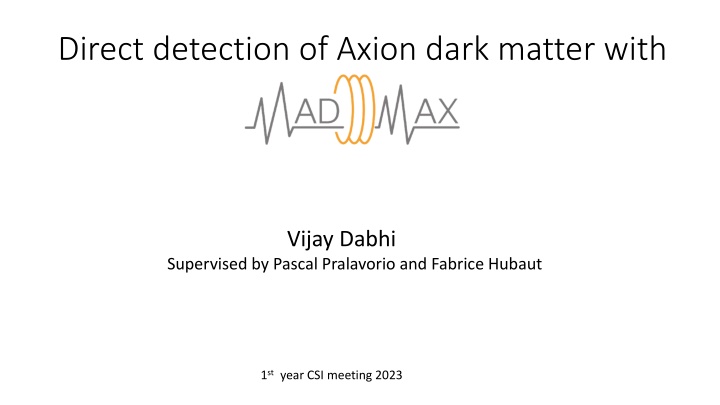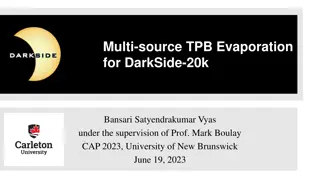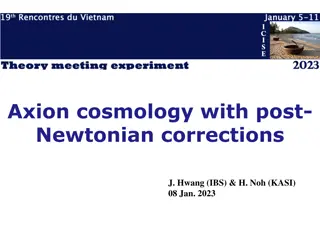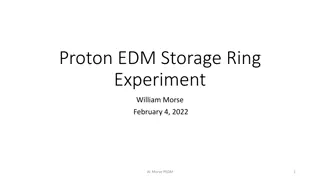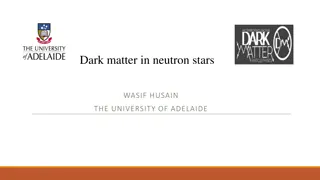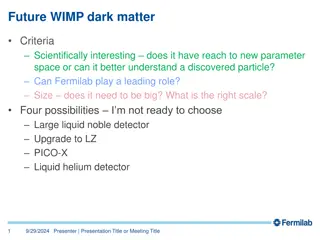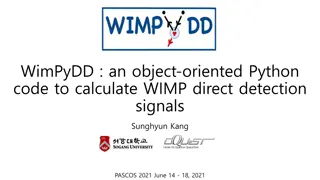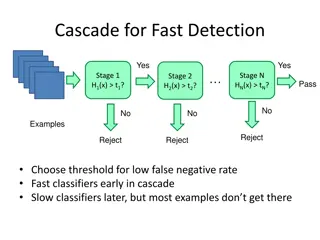Direct Detection of Axion Dark Matter: Advancements in Experimental Techniques
Researchers are investigating direct detection of axion dark matter using innovative technologies like the MADMAX dielectric haloscope. The project aims to boost signals, overcome challenges in probing higher mass ranges, and validate principles through prototypes like the P200 setup. Testing involves precise control of piezo motors for movement accuracy at cryogenic temperatures and high magnetic fields. Data analysis of motor tests in various conditions indicates progress towards achieving target precision.
Uploaded on Sep 21, 2024 | 1 Views
Download Presentation

Please find below an Image/Link to download the presentation.
The content on the website is provided AS IS for your information and personal use only. It may not be sold, licensed, or shared on other websites without obtaining consent from the author.If you encounter any issues during the download, it is possible that the publisher has removed the file from their server.
You are allowed to download the files provided on this website for personal or commercial use, subject to the condition that they are used lawfully. All files are the property of their respective owners.
The content on the website is provided AS IS for your information and personal use only. It may not be sold, licensed, or shared on other websites without obtaining consent from the author.
E N D
Presentation Transcript
Direct detection of Axion dark matter with .. Vijay Dabhi Supervised by Pascal Pralavorio and Fabrice Hubaut 1st year CSI meeting 2023
(fb) DM candidates (cm2) 1401.6085 8 orders of magnitude QCDAxion 10-5 10-13 balanced by abundance of DM particles stream from our galaxy halo O(0.1) GeV/cm3 moving at v=10-3c wrt earth Very feeble interaction with SM O(100) eV DM mass (GeV) [post-inflationary scenario suggests ma ~ 100 eV] 3 orders of magnitude Axion coupling to photons / ma Ca = 5 |ga | / ma 2020 Helioscopes 1801.08127 - O(1012)/cm3 ~ gaz High occupancy - Tiny mass & interaction Challenge: Boost the signal Haloscopes Very feeble signal 2030 Traditional cavities unable to probe higher mass ranges Yellow band: QCD- axion, i.e. solving strong CP pb Favored axion DM phase space 1 eV 1000 eV New technologies are needed to access the mass range > 10 eV Axion mass ma(eV) 2
MADMAX : a dielectric haloscope Constructive interference (resonance) of coherent photon emission at dielectric layers surface (~leaky resonators cavities) Ca = 5 |ga | / ma Thermal Noise Booster P (W) Tsys = Tbooster + Tamplifier Inverse primakoff effect Frequency Axion mass scan : by moving discs with m precision piezo motors at 4K under 10 T (50 MHz step) Construct several prototypes to validate the principles : Name P200 Setup Goal Available 2021 Challenges : - High B-field - Low Temp. (4 K) - m precision for mechanics 1 moveable disk, = 200 mm Piezo-motor + mechanics 3 fixed disks, = 100mm CB100 RF studies + First physics 2021 3 moveable disks, = 300 mm Scan ALP around 100 eV Proto-3 2024 3
P200 : testing the piezo motors Laser Sapphire disk To control the motor movements To measure motor positions Disk ring made at CPPM Principle of the measurement: precise control of 200 mm diameter sapphire disk position with three piezo motors Move the motors using a controller Motor positions measured using laser interferometers and tiny mirrors on the disk with precision better than 100 nm Position error d = target position (provided to the controller) actual position (measured by the interferometer) 4
P200 : measurement results The motors were tested in 2022 at room temperature (DESY), at cryogenic temperatures (CERN), and in magnetic field (CERN MORPURGO) I performed some data analysis to produce summary-benchmark plots of the tests Horizontal lines shows the target precision d The triangles show the measured position error during forward and backward motion Distance covered by motors (mm) Motors/mechanics work at cold temperature (5K) and high magnetic field (1.6 T) The accuracy of piezo motor positioning is close to target precision (< 10 m) Paper in preparation 5
CB100 experimental run at CERN Goal: To understand the RF response of the system and perform an ALP search 10 cm Morpurgo magnet Booster Mirror + 3 sapphire disks CB100 booster Receiver chain Taper Wave guide Magnetic field availability was very stable - 95% availability during 21 days of data taking LNA Network analyser CB100 booster prototype 6
CB100 experimental run at CERN 2023 Morpurgo magnet CB100 booster Receiver chain Booster dip The gaussian function fits very well to the residual. This shows that there is no anomalies/axion signal in the data. The averaged signal observed at the spectrum analyser. The top subplot shows the residuals in the data due to noise. Analysis on going Paper in preparation 7
Proto-3 : disk measurement ( = ) ( = ) ( = ) Vacuum The planarity scatter plot with ~500 points of measurement. The colors show the variation in the height of the sapphire disk surface (in mm). The min-max variation *of surface height is ~200 m with 52 m RMS deviation. All the disks appear to be in a somewhat bowl shape. I performed simulations of the proto-3 setup using the measured disk shapes to optimize the boost factor ( ) by choosing the disks and orientations Planarity of 4 sapphire disks of 300 mm diameter and 1 mm thickness were measured at CPPM with O(1) m precision 8
Proto-3 : boost factor simulation Simulation using a software package developed by the MADMAX collaboration based on the theoretical paper: arXiv:1906.02677 The boost factor is modified after taking into account the realistic shapes of the disks Some disk configurations perform better than the others Work on going Plan to conclude by end 2023 Shape of the electric field on the receiver side in presence of real disks 9
Plan for the coming years Name P200 CB100 setup Task 1 moveable disk 200 mm 3 fixed disks = 100mm 4 fixed disks = 200 mm 3 moveable disks = 300 mm Analysis ongoing, a paper in making Analysing 2023 data, possible experimental run at cold and in magnetic field at CERN 2024 Possible experimental run at cold and in magnetic field at CERN 2024 Plan to analyse the calibration data and visit DESY again in December 2023. CB200 Proto-3 2021 2025 2028 Booster inside proto cryostat and 1.6 T magnet (CERN) Final MADMAX booster inside 10 T magnet Proto booster CB 100 We are here!!! 10 10
Courses and presentations MADMAX Presentations : 3 Presentation at MADMAX simulation meetings 1 presentation at MADMAX collaboration meeting Talks foreseen at JRJC (Oct. 2023) and DMLab (Nov. 2023) ED Courses: Dark matter from phenomenological perspectives 15 h Ethique de la recherche 10 h Research integrity in scientific professions 10 h French as a foreign language 24 h French as a foreign language 24 h scientific training: 15/50 hours Professional training: 68/50 hours 11
CP violation in strong interaction QCD Lagrangian has CP violating terms It should lead to a neutron magnetic moment (dN) of O(10-16) e cm ? Current experiments give upper bound of dN < 10-26 e cm ? leading to |?| < 10-10 Strong CP problem: Why is the value of ? so small? Peccei Quinn mechanism: introduction of a new symmetry which is broken at some energy scale to generate a goldstone boson called Axion Solves the strong CP problem 13
Disk measurements with contact (mm) Z X Y 14
Using disk measurement interpolation 2.5 mm * 2.5 mm Disk 1 faces has less deviations in the surface measurement ( lower rms values) than disk 2 15
P200 in cryostat P200 tests P200 in magnetic field 16
18 Credit: Jacob Egge, University of hamburg
19 Credit: Juan Maldonado, MPP Munich
